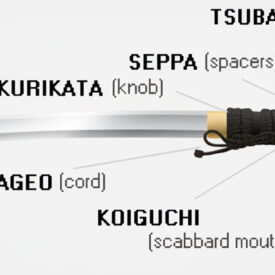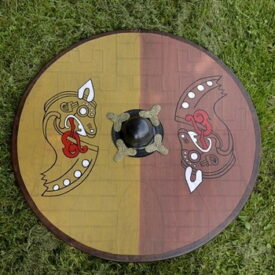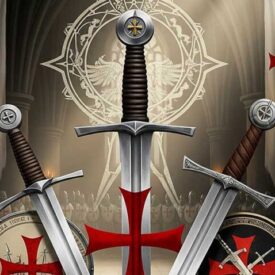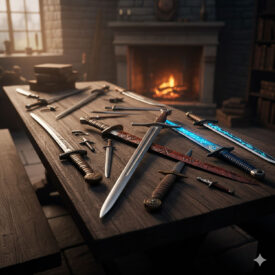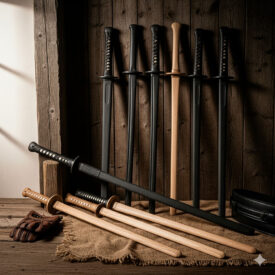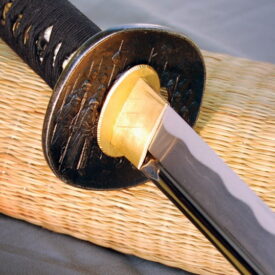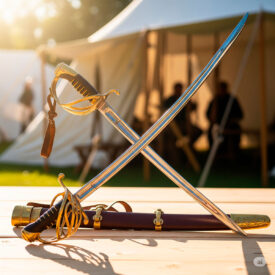What images come to mind when you think of German swords? A greatsword slicing the air on the battle line, a short, wide blade ready for close combat, or the signature of a legendary swordsmith engraved in steel. German swords are not just metal objects: they are technological responses to changing tactics, symbols of status, and pieces that still inspire smiths and collectors.
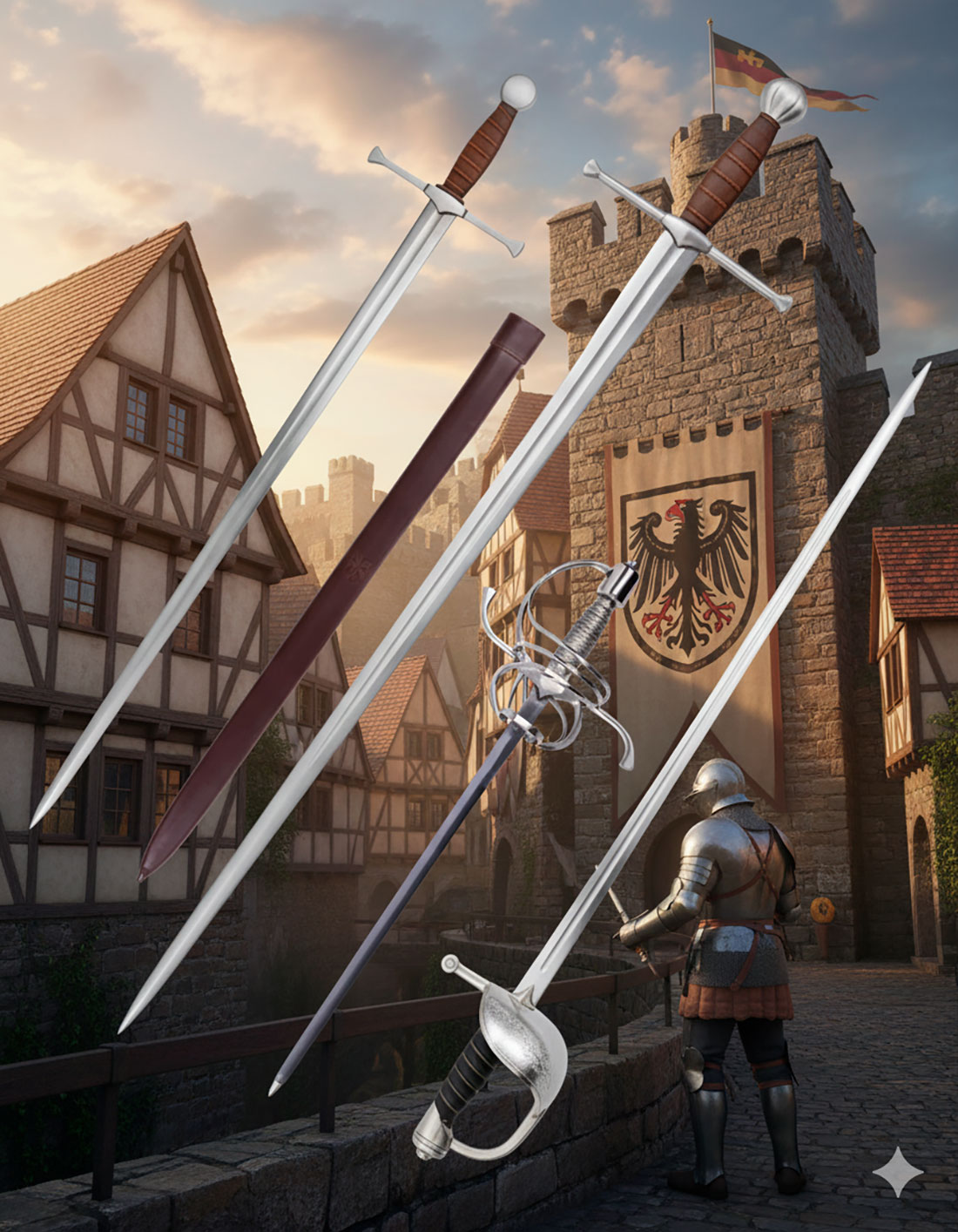
The Historical and Technical Importance of German Swords
In the Late Middle Ages and the Central European Renaissance, designs emerged that defined combat: from the short and robust Katzbalger to the imposing Zweihänder. These weapons reflect how the evolution of armor, formations, and metallurgy conditioned the shape and function of the blade. In this article, you will learn to distinguish types, explore their chronological evolution, understand their tactical function, and receive keys to identifying faithful replicas.
Essential Chronology of German Swords
The evolution of German swords is a story of metallurgical centers, innovations, and tactical adaptations. Here are the milestones that mark this trajectory.
| Era | Event |
|---|---|
| Origins and Early Middle Ages (up to 13th century) | |
| Antiquity / Early Middle Ages | Solingen, a key center for iron smiths in Northern Europe, has been active in metallurgy for approximately 2000 years and gains fame as a blacksmithing center. |
| 1067 A.D. | First documented mention of Solingen. |
| Late Early Middle Ages | Solingen swords are noted in Anglo-Saxon kingdoms and the British Isles. |
| c. 1100 – 1700 | General service period of the longsword in Europe. |
| Late Medieval Period and Transition (13th–16th centuries) | |
| 13th Century | Longswords or montantes begin to be used as part of the evolution of medieval swords in response to the development of plate armor. |
| 1250–1380 | Popularization of subtype Type XIIa, the “great German sword,” a specialization of Type XII oriented towards cavalry and heavy combat. |
| 1330–1500 | Common use of Type XVa, a hand-and-a-half version (transition sword) designed for thrusting. |
| 1350–1450 | Existence of Type XXa, a hand-and-a-half sword less wide and more oriented towards thrusting. |
| 1400–1430 | Documentation of hand-and-a-half sword examples, probably of German origin. |
| 14th–15th Centuries | Heyday of great battle swords (Zweihänder or montante), popular in Central Europe (Germany and Switzerland) for specialized troops. |
| 15th–16th Centuries | The Zweihänder (greatsword) is widely used in the Renaissance era; in the 16th century, it is employed by German Landsknechts under Emperor Maximilian I. |
| 1450–1600 | Development and use of the Katzbalger, a short, one-handed sword with an “S”-shaped guard and fish-fin pommel, characteristic of German Landsknechts. |
| 17th Century | |
| 17th Century | 17th-century swords are documented, such as the Landsknecht Sword (No. 670) and a German sword (No. 657) with a grid hilt. Solingen swordsmith marks appear, for example, “Welheim Dinger ihn Solingen” on a hanger. |
| Market and prices (1627–1690) | German blades are highly valued in the Castilian market, second only to Toledo blades. Spanish pragmatics set maximum prices: 13 reales (1627) and 18 reales (1680). In 1690, a master swordsmith in Logroño had 200 German sword blades. |
| 18th Century – Early 19th Century | |
| 18th Century | An 18th-century spontoon (No. 627) shows a Germanic eagle engraved on the blade; these weapons distinguished commanders and officers. |
| Last third 18th c. – early 19th c. | A consular sword (No. 90) from this period bears the name Solingen engraved on the blade, evidencing the city’s reputation and export. |
| 19th Century (industrialization and technical advances) | |
| 19th Century | The blade industry in Solingen is transformed by technical advances: introduction of new steels and mechanization of processes, revolutionizing the production of blades and cutting tools. |
| 20th Century (contemporary era and Third Reich) | |
| World War II / 20th Century | Continuity of the German arms tradition with standard pieces: existence of the German Hilt Sword Model 1890 for NCOs of the Heer (Wehrmacht). The manufacturer of this saber was Carl Eickhorn, from Solingen. |
Emblematic Types: Katzbalger, Zweihänder, Ulfberht, and the Longsword
German swords are not a single model: they respond to tactical roles. Here we break down the most iconic ones so you can understand their purpose and use.
Katzbalger: the Close Combat Sword
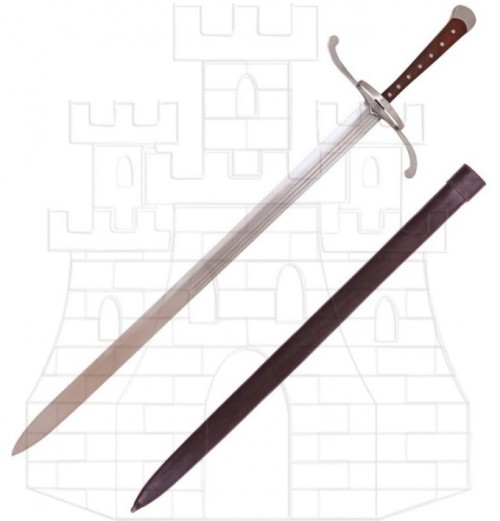 The Katzbalger is a short, wide sword that excelled in formations where space was limited. Its “S”-shaped guard protected the hand and facilitated quick deflections. It was the ideal secondary weapon for Landsknechts, pikemen, or crossbowmen who needed solid defense when the pike or bow were no longer useful. Its blade, with one or more “fullers” to lighten the weight, offers a balance between cutting and thrusting capability.
The Katzbalger is a short, wide sword that excelled in formations where space was limited. Its “S”-shaped guard protected the hand and facilitated quick deflections. It was the ideal secondary weapon for Landsknechts, pikemen, or crossbowmen who needed solid defense when the pike or bow were no longer useful. Its blade, with one or more “fullers” to lighten the weight, offers a balance between cutting and thrusting capability.
Zweihänder: the Greatsword that Broke Formations
The Zweihänder represents the great solution for scenarios where breaking lines or intimidating the enemy was necessary. With lengths that could exceed two meters and long hilts, these weapons demanded training and strength. They were shock weapons: they opened gaps against pikes and disorganized enemy ranks, serving specialized troops within the Landsknechts.
Ulfberht and the Mark of Metallurgy
Ulfberht swords, predating the High Middle Ages, are synonymous with blade quality. Their fame lies in high-purity steel and the mark that claimed a superior manufacturing standard. Although historically earlier than the Zweihänder, their metallurgical excellence influenced subsequent generations of German swords.
The Longsword and Tactical Transitions
Between the short sword and the greatsword appears the longsword or hand-and-a-half sword. Designed to be versatile, it combined cuts with thrusts and allowed for gradual adaptation to the use of more complex armor. It was the tool of trained knights and combatants who needed a balance between reach and maneuverability.
| Type | Blade Length (approx.) | Hilt | Tactical Function |
|---|---|---|---|
| Katzbalger | 60–75 cm | One hand, “S”-guard | Close combat and secondary defense |
| Longsword | 90–120 cm | One hand or hand-and-a-half | Versatile: cuts and thrusts |
| Zweihänder | 120–213+ cm | Two hands, long hilt | Breaking formations and reaching blows |
| Ulfberht (historical type) | 75–85 cm | One hand, lobed pommel | High blade quality, quick cuts |
Design and Metallurgy: Why German Swords Performed in Combat
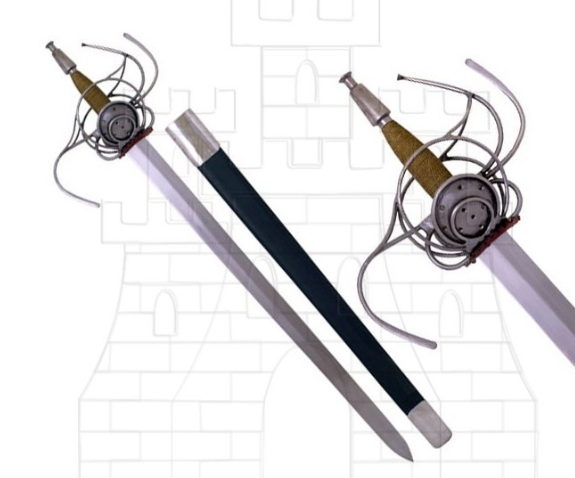
The efficiency of these swords is no coincidence. The blades featured fullers to reduce weight without sacrificing rigidity. Profiles could be lenticular for improved penetration or flatter for powerful cuts. The balance between the blade, guard, and pommel determined handling: a well-balanced sword is not rendered useless by its length or mass.
The tradition of armory centers like Solingen guaranteed tempering techniques and steel selection that made a difference: a flexible blade that does not break and retains its edge, or a stiffer blade for heavy blows. This combination of materials and technique allowed German swords to adapt to very different tactical roles.
How to Distinguish a Faithful Replica from a Decorative Copy
If you are considering a current replica, there are specific signs that betray its technical fidelity:
- Profile and temper: A combat replica shows a consistent line between blade and ricasso and a visible temper in the grain of the steel if it is polished.
- Balanced weight: Although long, swords like the Zweihänder should have a balance point that allows for handling. Excessive weight at the tip suggests a decorative piece.
- Materials: Look for carbon steel or specific steels for functional replicas; soft alloys and poor finish usually indicate decoration.
- Finishes and rivets: Welds, rivets on the handguard or pommel should be consistent and functional; purely aesthetic rivets are usually a sign of a non-functional finish.
Historical Techniques and Combat Use
The tactics that justified each type of sword are as important as the blade itself. The Katzbalger shone in fights where space was limited. The Zweihänder was trained for coordinated maneuvers that broke pikes or disorganized vanguards. The longsword responded to the need for versatility: a weapon with which the trained knight or foot soldier could effectively deliver cuts and thrusts.
Beyond combat, many swords served a symbolic function: engraved pommels or signed blades represented status and origin. Knowing how to read these details helps identify the original intent of the piece.
Swords and Replicas Available Today
If you are interested in seeing modern examples that revive these traditional designs, you will find replicas that respect proportions, materials, and finishes. Some seek functionality, while others focus on historical appearance. Knowing the difference will allow you to choose judiciously for collection, reenactment, or technical use.
Clarifying Doubts About Medieval German Swords
What are the main differences between the Katzbalger and the Zweihänder?
The main differences between the Katzbalger and the Zweihänder are:
- Size and length: The Katzbalger is a short sword, with a blade length between 70 and 80 cm, designed for close combat. In contrast, the Zweihänder is a much longer two-handed sword (often exceeding 1.2 meters), used to deliver powerful blows and have greater reach.
- Use and function: The Katzbalger was an auxiliary weapon for soldiers like the Landsknechte, used in hand-to-hand combat when other weapons such as pikes or bows were not effective. The Zweihänder, due to its size and weight, was employed to break pike formations or to gain a reach advantage in battles.
- Hilt design: The Katzbalger has a one-handed grip with a characteristic S- or figure-8-shaped guard, focused on defense and quick cuts. The Zweihänder has a two-handed hilt, allowing for greater control in wide, heavy blows.
- Type of attack: The Katzbalger is primarily a cutting sword, although it can be used for limited thrusting, while the Zweihänder combines powerful cuts with strong thrusts thanks to its size and two-handed grip.
The Katzbalger is a short, robust sword for close-quarters combat with one hand, focused on cuts, while the Zweihänder is a long, two-handed sword, used for more forceful attacks and with greater reach.
What characteristics make medieval German swords unique?
Medieval German swords are characterized by robust, functional designs with distinctive details that make them unique. For example, the Katzbalger, used by German Landsknechts, stands out for its short, wide, and strong blade, its “S”-shaped guard that protects the hand and allows for deflecting blows, and a fish-fin-shaped pommel that offers excellent balance for agile combat in confined spaces. Additionally, its blade often features fullers that reduce weight and increase the flexibility and strength of the steel.
Another notable characteristic is the high quality of the steel used in some medieval German swords, such as the Ulfberht swords, made from high-carbon crucible steel, which gave them greater hardness and flexibility, better resisting wear and impact.
These medieval German swords are distinguished by:
- Functional design for close and formation combat, with protective guards and balanced pommels (e.g., Katzbalger).
- Wide and short blade or adjusted according to function, with fullers to lighten weight.
- Use of high-quality steel, such as crucible steel in Ulfberht, offering superior hardness and flexibility.
- Tactical adaptation to different types of combat and roles within the army, from secondary weapons to versatile swords for cutting and thrusting.
These characteristics differentiate them from other medieval European swords, giving them a unique stamp in terms of design, functionality, and material quality.
How did German metallurgy influence sword manufacturing during the Middle Ages?
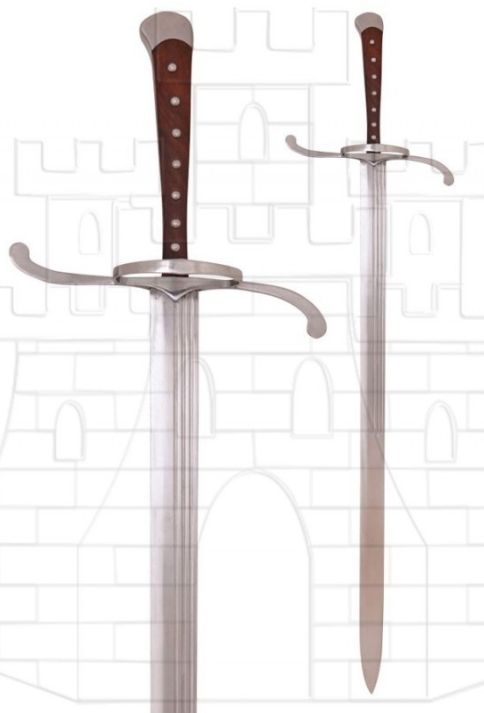 German metallurgy significantly influenced sword manufacturing during the Middle Ages by perfecting advanced forging techniques that allowed the production of high-quality steel blades, combining hardness and flexibility. This resulted in robust, lightweight swords with greater cutting capability and durability, characteristics that made German swords famous, including those produced by renowned smithing dynasties such as those associated with the name Ulfberht. These metallurgical techniques also allowed for the manufacture of swords with balanced and efficient designs for combat, which influenced the evolution of medieval bladed weapons in Europe. Furthermore, the tradition and precision in German manufacturing remained relevant from the High Middle Ages to later eras.
German metallurgy significantly influenced sword manufacturing during the Middle Ages by perfecting advanced forging techniques that allowed the production of high-quality steel blades, combining hardness and flexibility. This resulted in robust, lightweight swords with greater cutting capability and durability, characteristics that made German swords famous, including those produced by renowned smithing dynasties such as those associated with the name Ulfberht. These metallurgical techniques also allowed for the manufacture of swords with balanced and efficient designs for combat, which influenced the evolution of medieval bladed weapons in Europe. Furthermore, the tradition and precision in German manufacturing remained relevant from the High Middle Ages to later eras.
What role did German swords play in cavalry combat?
German swords in medieval cavalry combat played a fundamental role as versatile weapons and symbols of status. They were one-handed, straight, double-edged weapons, designed to allow quick and precise attacks from horseback, facilitating both cutting and thrusting. Additionally, their size and shape made them manageable during mounted combat, allowing knights to strike with agility and seek vulnerable points in enemy armor. Beyond their practical battlefield function, swords symbolized the honor and rank of knights, being an essential part of their identity and status in medieval society.
What are the most recognized German swords and why?
The most recognized German swords are the Zweihänder and the Ulfberht sword.
The Zweihänder is famous for being a large sword primarily used in the Renaissance, especially by 16th-century German Landsknechts. It stands out for its large size, reaching up to 2.1 meters and weighing between 2 and 4 kg, with some ceremonial versions up to 7 kg. It was used to break through military formations and is legendary for its supposed ability to decapitate with a single blow, as attributed to Pier Gerlofs Donia, a well-known user of this sword.
The Ulfberht sword dates back to the late 8th and early 9th centuries. It is recognized for its high metallurgical quality, centuries ahead of its time, with steel purity comparable to modern steel, which made it a prized weapon among nobles and warriors. It had a double-edged blade of 75 to 85 cm, lightweight (around 1.2-1.4 kg), and designed for fast, powerful cuts, with a characteristic lobed pommel hilt.
| Type of oil | Main Characteristics | Recommended Use |
|---|---|---|
| Mineral oil | High penetration, does not degrade or attract dirt | Regular protection and maintenance |
| Camellia oil | Natural, acid-free, non-volatile | Antioxidant protection, lubrication |
| Lithium grease | Dense, durable, does not evaporate | Long-term storage, protection |
Basic Care and Maintenance for Functional Replicas
Maintaining a replica in good condition does not require special tools but does require consistency. Clean it after use and apply a light coat of mineral or camellia oil to protect the blade from oxidation. Do not use oils with corrosive additives and avoid prolonged humidity.
- Cleaning: dry cloth for residue, then cloth with oil.
- Storage: in a dry sheath or on a stand that allows ventilation.
- Inspection: check rivets and fastenings after training or reenactment.
How Swords are Documented: Marks, Pommels, and Engravings
Engravings on blades and workshop marks are clues for the historian or collector. Solingen, signatures like Ulfberht, or medieval office marks can indicate origin or quality. Learn to read hallmarks, marks, and finishes: they are material testimonies of the production chain.
What to Choose According to Your Purpose?
Your choice should align with its intended use: collection, historical reenactment, or training. For reenactment, prioritize replicas with controlled temper and solid rivets; for display, decorative finish may take precedence; for technical practice, look for pieces with good balance and appropriate steel.
Recommendations for Verifying Authenticity and Quality
- Consult technical documentation: manufacturer’s sheets, materials, and detailed photos.
- Examine the balance point: this helps determine if the piece is designed for actual handling.
- Inspect welds and rivets: functionality over aesthetics.
- Ask for certifications: some manufacturers offer proof of temper or steel type.
Legacy and Contemporary Presence
Today, German swords live on in replicas for reenactment, collections, and as inspiration in historical martial arts. The tradition of forging, especially in regions like Solingen, remains a reference for its combination of technique and quality. Understanding their historical context enriches both aesthetic appreciation and the selection of a replica.
One last idea connects past and present: each blade tells a technical and tactical decision. Knowing how to read it puts you in the best position to appreciate, preserve, and enjoy a sword with discernment.
